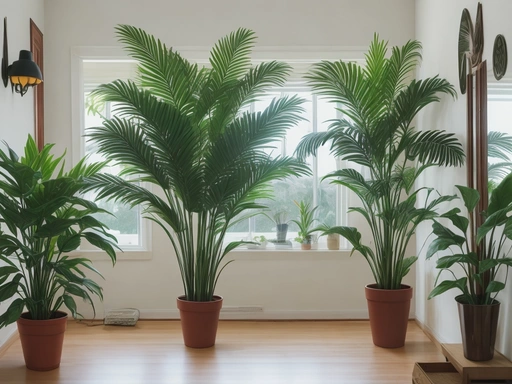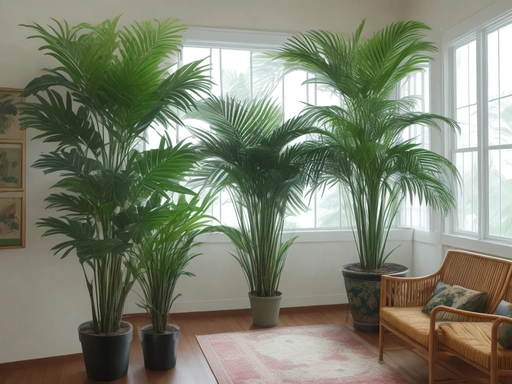Parlor Palm And Celebrating Plant Milestones: Green Thumb Delight!
Key Takeaways:
- Parlor palm is a popular indoor plant known for its easy care and resilience.
- Celebrating plant milestones, such as new growth or flowering, can bring joy and a sense of accomplishment to plant owners.
Are you a plant lover looking for a reliable, low-maintenance companion?
Look no further than the parlor palm.
This charming houseplant has a fascinating history and unique features that make it a popular choice among indoor gardeners.
But the fun doesn’t stop there! In this article, we will dive into the world of parlor palms, exploring everything from their care requirements to the exciting art of celebrating plant milestones.
Join me as we discover the joys of nurturing these green beauties and finding creative ways to mark their growth and achievements.
| Topic | Parlor Palm | Celebrating Plant Milestones |
| Scientific Name | Chamaedorea elegans | N/A |
| Plant Type | Indoor plant | N/A |
| Origin | Mexico and Guatemala | N/A |
| Size | Up to 6 feet (1.8 meters) tall | N/A |
| Lighting Requirements | Low to medium indirect light | N/A |
| Watering Frequency | Allow top inch of soil to dry out between waterings | Depends on plant type |
| Humidity Requirements | Tolerates average indoor humidity | Depends on plant type |
| Temperature Range | 60-75°F (15-24°C) | Depends on plant type |
| Air Purifying | Yes | N/A |
| Benefits | Improves air quality, easy to care for, adds beauty to indoor spaces | Creates a sense of accomplishment and joy |
| Drawbacks | Can be toxic to pets if ingested | N/A |
What is a parlor palm?
A parlor palm is a small and elegant houseplant that is known for its feathery green foliage and ability to thrive in low-light conditions.
History and origin of parlor palms
Parlor palms, also known as Chamaedorea elegans, have a fascinating history and origin. These plants are native to the rainforests of Mexico and Guatemala, where they grow as understory plants under the shade of taller trees.
Parlor palms became popular as houseplants in the Victorian era, when people began bringing them indoors to decorate their parlors and living spaces.
Since then, they have remained a beloved choice for indoor gardening due to their elegant appearance and ability to thrive in low-light conditions.
Features and characteristics of parlor palms
Parlor palms, also known as Chamaedorea elegans, are popular indoor plants due to their compact size and attractive foliage. Here are some key features and characteristics of parlor palms:
- Size: Parlor palms typically grow to a height of 2-6 feet, making them ideal for smaller spaces or tabletop displays.
- Foliage: The palm leaves are light green, feathery, and arch gracefully from the main stem. They have a delicate and elegant appearance.
- Low maintenance: Parlor palms are relatively low maintenance plants. They can tolerate various light levels, including low light conditions, and are resistant to pests and diseases.
- Air-purifying: Like many other palms, parlor palms are known for their ability to purify the air by removing toxins and increasing humidity.
- Slow growth: Parlor palms have a slow growth rate, which means they won’t outgrow their designated spot quickly. This makes them suitable for long-term indoor cultivation.
Overall, the features and characteristics of parlor palms make them a great choice for indoor gardeners who want an attractive, low-maintenance plant that can thrive in various light conditions.
Popular varieties of parlor palms
There are a few popular varieties of parlor palms that you might come across.
Here are a couple of them:
- Chamaedorea elegans: This is the most common variety, also known as the Neanthe Bella Palm or Parlor Palm. It has delicate, feather-like fronds and can grow up to 4 feet tall. It’s a great choice for indoor spaces with low light.
- Chamaedorea metallica: This variety, also known as the Miniature Fishtail Palm, has metallic blue-green fronds with a textured appearance. It grows to be about 2-3 feet tall and is a beautiful addition to any indoor space.
Remember, these are just a few examples, and there are other varieties of parlor palms out there as well.
It’s always good to do a little research and choose the variety that suits your preferences and the conditions in your home.
Caring for your parlor palm
Caring for your parlor palm involves paying attention to its light, temperature, watering, and fertilizing needs, as well as being aware of common pests and diseases.
Light requirements for parlor palms
Parlor palms thrive in bright, indirect light but can tolerate lower light conditions. Avoid direct sunlight, as it can scorch the leaves.
Place your parlor palm near a north- or east-facing window, or a few feet away from a west- or south-facing window.
Rotate the plant regularly for even growth.
Temperature and humidity needs of parlor palms
Parlor palms thrive in temperatures between 65-85°F (18-29°C), making them suitable for most indoor environments. They prefer moderate humidity levels, around 40-50%.
Avoid placing them near drafty windows or heating vents, as it can cause temperature fluctuations.
Mist the leaves occasionally to increase humidity.
Watering and soil requirements for parlor palms
When it comes to watering your parlor palm, it’s important to strike a balance.
Aim to keep the soil consistently moist but not soggy.
Allow the top inch of soil to dry out between waterings to prevent overwatering.
Use well-draining soil to avoid waterlogged roots.
Watering frequency will vary depending on factors like temperature and humidity.
In terms of soil requirements, parlor palms prefer a loose, well-draining potting mix.
A blend of peat moss, perlite, and regular potting soil works well.
Avoid heavy clay or compacted soil that can retain too much moisture.
Adding organic matter like compost can help improve soil quality and drainage.
Fertilizing and repotting tips for parlor palms
Fertilizing and repotting are important for the health of your parlor palm. Fertilize every 2-3 months during spring and summer using a balanced liquid fertilizer.
Repot every 2-3 years or when the roots outgrow the pot.
Use well-draining soil and a slightly larger pot. Avoid over-fertilizing and over-watering to prevent damage to your plant.

Common pests and diseases that affect parlor palms
Parlor palms can be affected by common pests like mealybugs, spider mites, and scale insects.
These pests feed on the leaves and can cause damage if not treated.
Diseases such as root rot and leaf spot can also affect parlor palms if they are overwatered or exposed to high humidity.
Regular monitoring and proper care can help prevent and manage these issues.
Celebrating plant milestones
Celebrate the milestones of your parlor palm to acknowledge its growth and achievements.
Understanding the growth stages of your parlor palm
Understanding the growth stages of your parlor palm is essential for proper care.
Parlor palms typically go through three main stages: seedling, juvenile, and mature.
The seedling stage lasts about 1-2 years, during which the plant grows slowly and develops its first leaves.
In the juvenile stage, the growth rate increases, and the plant produces more foliage.
Finally, in the mature stage, the parlor palm reaches its maximum height and displays its characteristic fullness.
By observing these stages, you can better assess your plant’s health and determine its needs.
Tracking the growth and development of your parlor palm
To track the growth and development of your parlor palm, there are a few things you can do.
Firstly, you can measure the height of your plant regularly using a ruler or measuring tape.
Secondly, take note of any new leaves that emerge, as this is a sign of growth.
Additionally, you can keep a photo diary to visually document the changes in your plant over time.
It’s also helpful to observe any changes in leaf color, texture, or overall appearance, as these may indicate the plant’s health and development.
By tracking these aspects, you’ll have a better understanding of how your parlor palm is progressing.

Documenting the milestones and achievements of your parlor palm
Documenting the milestones and achievements of your parlor palm is a fun way to track its growth and progress.
You can take photos at different stages, noting when it sprouts new leaves or reaches certain heights.
Keep a journal to record any milestones like it flowering or producing new shoots.
Sharing your plant’s journey on social media is another great way to celebrate your parlor palm’s achievements and connect with other plant lovers!

Creative ways to celebrate your parlor palm’s milestones
Here are some creative ways to celebrate your parlor palm’s milestones:
- Take photos: Document the growth of your parlor palm by taking regular photos. Compare the pictures from different stages to appreciate its progress.
- Throw a “Green Party”: Host a small gathering with friends or family to celebrate your parlor palm’s milestones. Decorate the space with plant-themed decorations and serve green snacks and drinks.
- Share on social media: Post updates about your parlor palm’s milestones on social media platforms. You can create dedicated hashtags or even start a blog to share your plant journey with others.
- DIY crafts: Use fallen or pruned leaves to create beautiful crafts like pressed leaf bookmarks, framed leaf art, or even potpourri.
- Plant party favors: As your parlor palm reaches significant milestones, repot some of its offspring into small decorative pots. These can be given as party favors or gifts to friends and loved ones.
Remember, celebrating your parlor palm’s milestones is a fun way to appreciate its growth and the joy it brings to your space.
Get creative and have fun!

Frequently Asked Questions
How often should I water my parlor palm?
Water your parlor palm when the top inch of soil feels dry to the touch.
Stick your finger into the soil to check.
Typically, watering once every 1-2 weeks is sufficient, but adjust based on your home’s temperature and humidity.
Avoid overwatering, as it can lead to root rot.
Can I keep my parlor palm in a low-light area?
Yes, you can keep your parlor palm in a low-light area.
Parlor palms are tolerant of low light conditions and can survive in areas with indirect or partial sunlight.
Just make sure to keep the soil moist and avoid placing it in complete darkness.
How do I know if my parlor palm needs repotting?
If your parlor palm is showing signs of root crowding, such as roots growing out of the drainage holes or circling around the pot, it may need repotting.
Other signs include a decline in plant health, slow growth, and the potting mix staying wet for longer periods.
What are some signs of pests and diseases in parlor palms?
Signs of pests and diseases in parlor palms include yellowing or browning leaves, stunted or distorted growth, leaf spots or discoloration, webbing or sticky residue on leaves, and presence of pests like spider mites, mealybugs, or scale insects.
Regular inspection helps catch these issues early.
Final Verdict
The parlor palm is an elegant and low-maintenance houseplant that can bring a touch of nature and tranquility to any indoor space. With its rich history and beautiful features, it’s no wonder why it has become such a popular choice among plant enthusiasts.
By providing the right care, including proper lighting, temperature, and watering, you can ensure that your parlor palm thrives.
And don’t forget to celebrate your plant’s milestones along the way, whether it’s a new leaf or a growth spurt. Documenting these achievements and finding creative ways to celebrate them can not only deepen your connection with your plant, but also bring joy and fulfillment to your own life.
So, go ahead and embrace the wonderful journey of nurturing and celebrating your beloved parlor palm.







